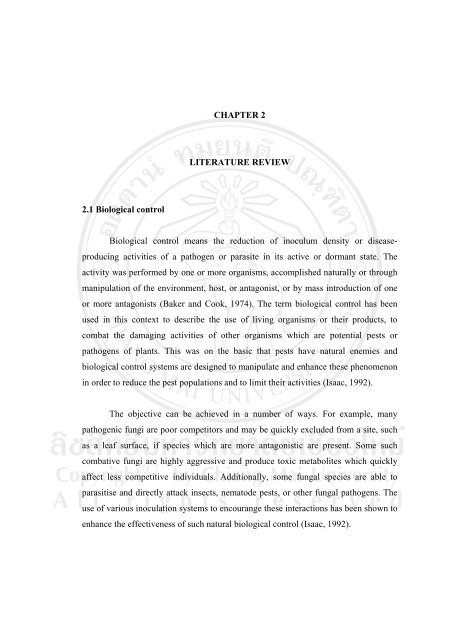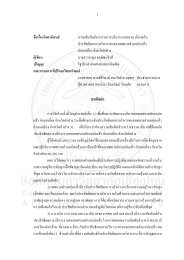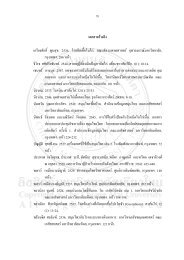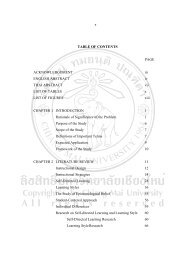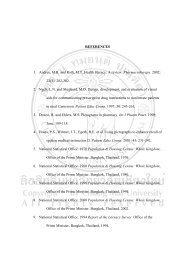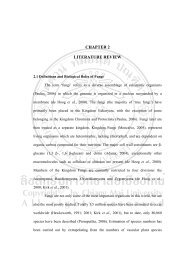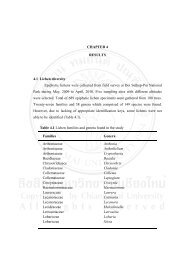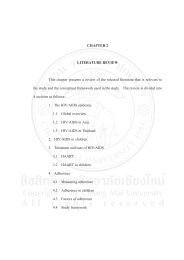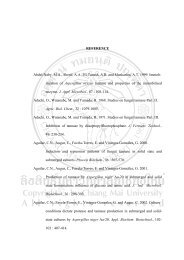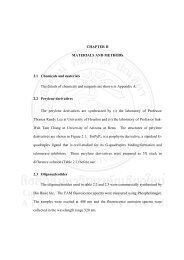CHAPTER 2 LITERATURE REVIEW 2.1 Biological control Biological ...
CHAPTER 2 LITERATURE REVIEW 2.1 Biological control Biological ...
CHAPTER 2 LITERATURE REVIEW 2.1 Biological control Biological ...
Create successful ePaper yourself
Turn your PDF publications into a flip-book with our unique Google optimized e-Paper software.
<strong>CHAPTER</strong> 2<br />
<strong>LITERATURE</strong> <strong>REVIEW</strong><br />
<strong>2.1</strong> <strong>Biological</strong> <strong>control</strong><br />
<strong>Biological</strong> <strong>control</strong> means the reduction of inoculum density or diseaseproducing<br />
activities of a pathogen or parasite in its active or dormant state. The<br />
activity was performed by one or more organisms, accomplished naturally or through<br />
manipulation of the environment, host, or antagonist, or by mass introduction of one<br />
or more antagonists (Baker and Cook, 1974). The term biological <strong>control</strong> has been<br />
used in this context to describe the use of living organisms or their products, to<br />
combat the damaging activities of other organisms which are potential pests or<br />
pathogens of plants. This was on the basic that pests have natural enemies and<br />
biological <strong>control</strong> systems are designed to manipulate and enhance these phenomenon<br />
in order to reduce the pest populations and to limit their activities (Isaac, 1992).<br />
The objective can be achieved in a number of ways. For example, many<br />
pathogenic fungi are poor competitors and may be quickly excluded from a site, such<br />
as a leaf surface, if species which are more antagonistic are present. Some such<br />
combative fungi are highly aggressive and produce toxic metabolites which quickly<br />
affect less competitive individuals. Additionally, some fungal species are able to<br />
parasitise and directly attack insects, nematode pests, or other fungal pathogens. The<br />
use of various inoculation systems to encourange these interactions has been shown to<br />
enhance the effectiveness of such natural biological <strong>control</strong> (Isaac, 1992).
4<br />
<strong>Biological</strong> <strong>control</strong> systems are preferred to the use of chemicals and in recent<br />
years a great deal of research activity has been directed towards the development of<br />
efficient and reliable systems. In environmental terms the effects and long term<br />
consequences of biological <strong>control</strong>, are much less damaging than the routine use of<br />
pesticides or fungicides. Treatments can be economic and cost-effective providing<br />
that good <strong>control</strong> can be established, particularly when repeated chemical spraying is<br />
required during the growing season. <strong>Biological</strong> systems have great potential in the<br />
<strong>control</strong> of soil-borne microbes which are particularly difficult to treat by spraying<br />
alone. Since the pest and antagonist are developing within a natural situation, there<br />
will be co-evolution between them and the potential for the development of stable<br />
resistance to the biological <strong>control</strong> agent is much reduced from that of chemical<br />
treatments (Briese, 1986).<br />
It is interesting that relatively few instances of biological <strong>control</strong> have been<br />
effectively implemented in commercial field situations to date. Much research has led<br />
to the development of efficient systems on laboratory or greenhouse scales where the<br />
environment is highly <strong>control</strong>led and predictable. However, once trials are scaled up<br />
the extreme variability and unpredictability of natural field sites can lead to problems.<br />
In theory, biological <strong>control</strong>, once established in a balanced situation, could be selfperpetuating<br />
but in practice such systems are more often used as part of an integrated<br />
<strong>control</strong> programme with pesticides and fungicides as supplementary treatments (Way,<br />
1986; Burge, 1988) in much reduced quantities.<br />
Example of plant protection by biological <strong>control</strong> including tomato, bell<br />
pepper, celery and citrus. They were propagated in planting mixes amended with<br />
formulations of commercial bio<strong>control</strong> agents. Root colonization by selected<br />
bio<strong>control</strong> agents was evaluated for pepper, tomato and citrus, and found to be<br />
generally between 76 to 100% in both greenhouse ebb and flow, and bench-produced<br />
plants. All biological <strong>control</strong> agents, Trichoderma harzianum, Bacillus subtilis, G.<br />
intraradices, Gliocladium virens, and Streptomyces griseovirdis reduced crown rot of<br />
tomato in the field, with T. harzianum and B. subtilis being the most effective<br />
uniformly among four tests. Four bio<strong>control</strong>s reduced Phytophthora root rot on citrus
5<br />
in the field, two applied as a drench to soil in pots reduced Thietaviopsis root rot on<br />
citrus, and two bio<strong>control</strong> agents in combination reduced celery root rot caused by<br />
Pythium and Fusarium spp. (Nemec et. al., 1996). Six isolates of plant growthpromoting<br />
fungi (PGPF), non-pathogenic Fusarium oxysporum, and five isolates of<br />
bacteria were tested in hydroponic rock wool systems as potential bio<strong>control</strong> agents of<br />
Fusarium crown and root rot (FCRR) of tomato caused by Fusarium oxysporum f. sp.<br />
radicis-lycopersici (FORL) (Horinouchia et. al., 2006). In addition Arthrovacter spp.,<br />
Azotobacter spp., Pseudomonas spp., and Bacillus spp. was used to <strong>control</strong> Fusarium<br />
verticillioides in the maize rhizosphere. They were applied under greenhouse<br />
conditions and it was found that Azotobacter armeniacus inhibited all F.<br />
verticillioides strains assayed (Cavaglieri et. al., 2004).<br />
<strong>2.1</strong>.1 Factors involved in biological <strong>control</strong><br />
<strong>Biological</strong> <strong>control</strong> is important method to plant disease <strong>control</strong> because it save<br />
cost and it is more safety than using chemical. <strong>Biological</strong> <strong>control</strong> of plant diseases<br />
can occur via several distinct mechanisms, including competition for nutrients<br />
between a pathogen and harmless species, parasitism, and production of antibiotics.<br />
Mechanisms leading to biological <strong>control</strong> of plant pathogens are complex and may<br />
occur by many routes. Plant pathogens may be suppressed by events that reduce the<br />
potential inoculum level of the pathogen in the environment, or by competitive or<br />
parasitic interactions among organisms, or by competition for limiting resources.<br />
Competition may occur at any point in the infection cycle, from its initiation outside<br />
the host, through invasion and growth inside the plant. Some fungi such as species of<br />
Trichoderma exhibit mycoparasitism, attacking and killing hyphae or other parts of<br />
pathogenic fungi. Some bacteria, actinomycetes, and fungi produce chemicals<br />
(antibiotics) that actively repress the growth of other species, including pathogens.<br />
Some fungi repress the growth of pathogens by out competing them for key resources<br />
such as minerals, nutrients, oxygen, or water, either at or away from the site of initial<br />
infection (Van Driesche and Bellows, 1996).
6<br />
a. The host ; The host population in its wild state was always involved in<br />
biological <strong>control</strong> by being a part of the biological balance that helped keep the<br />
pathogen suppressed. If the host or crop plant is highly susceptible to the pathogen,<br />
severe disease losses will occur unless the environment is highly unfavorable or<br />
antagonists suppress the pathogens. The mechanism of resistance is known in only a<br />
few instances. In some cases, the host may be resistant because it stimulates<br />
antagonists to grow in its rhizosphere. Resistant varieties may be rendered susceptible<br />
by products of decomposition of organic matter in soil.<br />
b. The pathogen or parasite ; Pathogens and parasites are generally more<br />
sensitive to unfavorable a biotic factors than are saprophytes. Most pathogens invade<br />
the host early in the disease and, being internal, are generally protected from<br />
antagonists. In addition, secondary organisms may, however, invade diseased tissue<br />
and rot it.<br />
c. Physical environment ; Control of a disease through the inhibitory effects of<br />
the physical or chemical environment directly on the pathogen would not be a type of<br />
biological <strong>control</strong>, because it is not then operating through another organism.<br />
However, the environment may favor the host and causes it to maintain its resistance<br />
to facultative types of microorganism<br />
Conditions of the environment may be made unfavorable to the pathogen or<br />
vector. Tillage practices that modify the environment so as to favor antagonists are<br />
certainly part of biological <strong>control</strong>.<br />
An admittedly oversimplified schematic diagram of the major factor-groups<br />
acting to produce plant disease is shown in Figure <strong>2.1</strong>. Each factor-group is<br />
represented by a disk, and the amount of overlapping indicates the degree of<br />
interaction. Environment is collectively used to include several factors that might be<br />
operative; it could also refer to a single <strong>control</strong>ling factor.
7<br />
A<br />
C<br />
B<br />
D<br />
Figure <strong>2.1</strong> Schematic diagram of interactions in major factor-groups in plant disease.<br />
A. Severe disease loss. Susceptible crop moderately well adapted to the<br />
environment; pathogen well adapted; antagonists not well adapted and<br />
ineffective. Exemplified by the Fusarium wilt diseases in acid sandy soils.<br />
B. Slight disease loss. Susceptible crop well adapted to environment; pathogen<br />
poorly adapted; antagonists moderately adapted and quite effective.<br />
Exemplified by the Fusarium wilt diseases in alkaline clay soils.<br />
C. No disease loss; biological <strong>control</strong>. Susceptible crop, antagonists, and<br />
pathogen well adapted to environment. Antagonists have suppressed the<br />
pathogen. Exemplified by Phytophthora cinnamomi root rot of avocado in<br />
Queensland.<br />
D. No desease loss; resistance. Resistant crop, antagonists, and pathogen well<br />
adapted to environment. Host resistance prevents disease. Exemplified by<br />
Fusarium wilts in any soil when the crop carries monogenic resistance (Baker<br />
and Cook, 1974).
8<br />
d. Antagonists ; Any disease <strong>control</strong> in which antagonists are involved is<br />
biological <strong>control</strong>. Antagonism is now considered to include three types of activity:<br />
* Antibiosis and lysis. Antibiosis is the inhibition of one organism by a<br />
metabolic product of another. Although it is usually an inhibition of growth,<br />
it may be lethal. The metabolite may penetrate a cell and inhibit its activity<br />
by chemical toxicity. Lysis is a general term for the destruction,<br />
disintegration, dissolution, or decomposition of biological materials.<br />
Because of the variety of ways it can be produced, and the number of its<br />
effects on plant cells, confusion has resulted in the literature.<br />
∗ Competition. Competition was viewed by Clark (Baker and Snyder, 1965)<br />
as “the endeavor of two or more organisms to gain the measure each wants<br />
from the supply of a substrate, in the specific form and under the specific<br />
conditions in which that substrate is presented when that supply is not<br />
sufficient for both.” In essence, competition is for nutrients, particularly<br />
high-energy carbohydrates, but also nitrogen, and possibly certain growth<br />
factors.<br />
∗ Parasitism and predation. Although the existence of this type of biological<br />
<strong>control</strong> is not questioned, there is uncertainty about its actual importance<br />
under field conditions. Fungi known to parasitize other organisms are<br />
Rhizoctonia solani on Pythium, Trichoderma viride on Armillaria mellea,<br />
several genera of trapping fungi on nematodes, Fusarium roseum on rusts.<br />
The free-living nematode (Aphelenchus avenae), a ubiquitous fungivore,<br />
thrusts its stylet into a hypha and injects digestive saliva that liquified the<br />
contents, which are then sucked out through the stylet. Predatory nematodes<br />
such as Seinura rapidly paralyze other nematodes by injecting saliva and<br />
later sucking out the digested contents (Baker and Cook, 1974).
9<br />
Example of antagonistic microbes such as the activities of Trichoderma spp.<br />
are inhibitory to a range of fungi. Trichoderma harzianum mycoparasitises the<br />
mycelium of some other fungal species in soils, e.g. Rhizoctonia and Sclerotinia, and<br />
inhibits the growth of others, e.g. Pythium and Fusarium. The fungus Gliocladium<br />
virens mycoprasitises mycelium of Sclerotinia sclerotiorum (Isaac, 1992).<br />
For plant pathogen, biological <strong>control</strong> is the reduction of disease by any of<br />
these following action (Baker and Cook, 1974).<br />
1. Reduction of inoculum of the pathogen through decreased survival<br />
between crops.<br />
2. Reduction of infection of the host by the pathogen.<br />
3. Reduction of severity of attack by the pathogen.<br />
<strong>2.1</strong>.2 Mechanism of fungal biological <strong>control</strong><br />
A number of the natural characteristics of the life-styles of fungi confer<br />
qualities which make them potentially useful biological <strong>control</strong> agents against a<br />
variety of pests and pathogens of plants.<br />
There are several action of fungal biological <strong>control</strong> by following action.<br />
(a) Competitive ability<br />
The competitive activities of some fungi render them highly antagonistic and<br />
ideal as potential combative organisms. In theory, at least, increased levels of such<br />
species introduced to leaf surfaces would lower the potential rates of infection from<br />
other pathogenic fungal species, which tend to be less competitive and aggressive.<br />
(b) Antibiosis<br />
Antibiosis is defined as the inhibition of the growth of a microbe by<br />
substances produced and liberated by another microbe. The term most usually refers<br />
to antibiotic activity. However, whilst it is relatively easy to prove that an organism<br />
produces antibiotic in culture it is difficult to ascertain whether similar production<br />
occurs under natural conditions, and even more difficult to establish a role for these
10<br />
compounds in competition within natural environments. Little antibiotic activity has<br />
been detected in the soil environment and it has been suggested that these compounds<br />
are degraded or adsorbed no to soil particles. Additionally, a strain newly isolated<br />
from the environment may demonstrate antibiotic activity although this ability may be<br />
rapidly lost on subsequent subculture.<br />
(c) Mycoparasitism<br />
Fungi which derive most or all their nutrients from another fungus are termed<br />
mycoparasites. The term used to describe the direct parasitism of one parasite<br />
(usually a primary parasite) by another is hyperparasitism. Fungal preparations are<br />
now used and marketed commercially for <strong>control</strong> of insect pests and nematodes,<br />
particularly in <strong>control</strong>led, greenhouse conditions. All the major fungal taxonomic<br />
groups contain mycoparasitic species. Biotrophic mycoparasites may have relatively<br />
long-term associations with living cells of the invaded species; however, necrotrophic<br />
mycoparasites often kill the target fungal-host cells prior to penetration and invasion.<br />
Some mycoparasitic species are adapted to the exploitation of fungal spores,<br />
either asexual or sexual resting spores. Exploitation of this ability, particularly the<br />
mycoparasitism of sclerotia, would be of great agricultural and horticultural interest<br />
since these structures are extremely long-lived and very difficult to eradicate from soil<br />
(Isaac, 1992).<br />
2.2 Endophytes<br />
Endophytes was defined by Petrini (1991) as “all organisms inhabiting plant<br />
organs that at some time in their life, can colonise internal plant tissues without<br />
causing apparent harm to the host”. This definition therefore includes symptom less<br />
latent pathogens and those fungi which also hame an epiphytic phase of their life<br />
cycle. Wilson (1995) provided a “working definition” of the term by analyzing the<br />
different levels of endophyte association and stated that “endophytes are fungi or<br />
bacteria which, for all or part of their life cycle, invade the tissues of living plants and
11<br />
cause unapparent and asymptomatic infections entirely within plant tissues but cause<br />
no symptoms of disease”. Endophytic fungi are as highly specialized on their hosts as<br />
pathogenic fungi, but in contrast they colonize internal host tissue without manifest<br />
symptoms (Petrini and Ouellette, 1994).<br />
Fungal endophytes provide the protection to their host. For examplae, fungi in<br />
redwood may function as antagonists or stimulators to pathogens (Espinosa-García et.<br />
al., 1996). However, colonization or infection by endophytic organisms cannot be<br />
considered as causing disease, because a plant disease in an interaction between the<br />
host, parasite, vector and environment and symptoms are a result from the interaction<br />
(Rossman, 1997). The study of endophytes of tropical plants has received much<br />
attention because endophytes are believed to be both diverse and to provide an<br />
excellent potential source of biologically active novel compounds (Dreyfuss and<br />
Petrini, 1984; Hyde, 2001)<br />
2.<strong>2.1</strong> Characteristics of endophytes<br />
Endophyte produced alkaloids and other mycotoxins appear to be responsible<br />
for the resistance of plants. Several reviews discuss secondary metabolite production<br />
by endophytic fungi in graminicolous and non-graminicolous hosts (Miller, 1986;<br />
Clay, 1988, 1991; Petrini et. al., 1992). Furthermore, endophytic fungi alter<br />
relationships between diversity and ecosystem properties as shown in Figure 2.2 each<br />
species is represented by a circle that shows the amount of resources it exploits along<br />
two resource axes. Grey circles represent the grass species. If the grass hosts an<br />
endophyte, it experiences an increase in resource acquisition relative to its uninfected<br />
state. This increase will be the strongest when resources are most limiting (i.e. at<br />
greater levels of species diversity). As the infected grass is superior to the uninfected<br />
grass in resource acquisition, it can more strongly reduce the amount of resources<br />
available to other species (Jennifer et. al., 2004).
12<br />
Endophytes, in culture, can produce biologically active compounds (Brunner<br />
and Petrini, 1992) including several alkaloids, paxilline, lolitrems and tetraenone<br />
steroids (Dahlman et. al., 1991). When Eupenicillium spp. was isolated from healthy<br />
leaves of Murraya paniculata (Rutaceae) after surface sterilization, the fungus was<br />
cultivated in sterilized white-corn, where the spiroquinazoline alkaloids<br />
alanditrypinone, alantryphenone, alantrypinene and alantryleunone were produced<br />
(Barros, 2005). Endophytes, 155 fungi (91.7%) and 52 bacteria (64%), were found to<br />
produce xylanase. The inside part of plants is a novel and good source for isolating<br />
xylanase producers in comparison with soil (Suto et. al., 2002). Ergopeptine,<br />
peramine, and pyrollizadine based loline alkaloids are produced from Acremonium<br />
spp, these alkaloids are biologically active against numerous species of insects,<br />
including aphids (Johnson et. al., 1985; Prestidge et. al., 1982; Siegel and Schardl,<br />
1991). The alkaloids not only serve as feeding deterrents, but also decrease the<br />
reproduction and growth of the insects. Antibiotic compounds have also been<br />
produced in culture by endophytes (Fisher et. al., 1984a, b) and plant growth<br />
promoting factors have been recovered (Petrini et. al., 1992).<br />
Furthermore, endophyte was produced hormone for growth of plant. For<br />
example, root growth and morphology are affected by some auxin-producing<br />
mycorrhizae and Rhizobium bacteria (Leopole and Kriedemann, 1975). Auxin is a key<br />
hormone in regulating plant growth, differentiation, and apical dominance and is<br />
produced mainly in shoot meristems and expanding leaves. The endophyte is most<br />
prevalent near these organs. The plants from which the endophytes were isolated<br />
produced 24% greater biomass than did their nonsymbiotic isolines. Auxin<br />
concentrations in both plant types were unaffected by endophyte infection. May be<br />
expressions of differing defects on auxin concentrations or antagonisms by other<br />
hormones such as gibberellic acid (Bacon and White, 1994). Endophytic<br />
microorganisms exist within the living tissues of most plant species. They are most<br />
abundant in rainforest plants. Novel endophytes usually have associated with them<br />
novel secondary natural products and/or processes. For example, muscodor is a novel<br />
endophytic fungal genus that produces bioactive volatile organic compounds (VOCs).<br />
(Demain and Dijkhuizen, 2006)
13<br />
Evidence for the presence of endophytic fungi in many plants has been<br />
provided solely on the basis of isolations of the fungi from surface-sterilized tissue.<br />
From ecolofical and floristic analyses of a broad range of host species, it is apparent<br />
that endophytic fungi comprise a unique and complex ecological group distinct from<br />
obligate parasites and saprobes, although the ecological role of many endophytes is<br />
not well understood (Petrini, 1994).<br />
Figure 2.2 Graphical model depicting how mutualistic endophyte symbiosis in a<br />
common grass species can alter the relationship between species diversity and<br />
ecosystem functioning (Jennifer et. al., 2004).<br />
2.2.2 Host specificity<br />
The degree of host specificity which operates in the endophytic fungi is not<br />
yet clear. Some species are commonly occurring and may be isolated from various<br />
host plant species and from different locations with differing environmental<br />
conditions. In general terms, the geographical occurrence of endophytes is related to<br />
the distribution of host species. In some cases almost all individuals in a plant<br />
population may be infected by endophytes. Cladosporium spp., Nodulisporium spp.<br />
and Pleospora spp. are common. Some endophytes, however, do not show such a<br />
wide species range and are often isolated from plants of the same family or closely<br />
related families. Other species are only rarely detected (Isaac, 1992).
14<br />
The degree to which endophytes are tissue or organ-specific is also not yet<br />
clear. Some species are most commonly isolated from similar tissues, particularly the<br />
endophytes of conifer needles. In other cases the occurrence is less distinct.<br />
Howerver, only limited surveys have been carried out to date (Isaac, 1992).<br />
2.2.3 Isolation of endophytes<br />
The isolation and identification of endophytic species involves very careful<br />
surface sterilistion of host plant tissues followed by incubation on a range of media to<br />
encourage outgrowth of isolates and their subsequent sporulation, so that<br />
identification can be carried out. It is often difficult to satisfactorily establish<br />
endophytic status for the isolates which are obtained. It is not easy to ensure the<br />
exclusion of spores or hyphal fragments which may escape the sterilization (Petrini,<br />
1986). Some epiphytic species may penetrate host tissues and additionally some<br />
endophytic species sporulate in culture, although many isolates grow very slowly and<br />
a considerable incubation time (sometimes many months) is often required. Fungal<br />
endophytes of conifers are common although many belong to little known species,<br />
probably because these fungi are very inconspicuous and are rarely collected. Some<br />
species live almost entirely within a host plant cell. Rate of endphyte infection<br />
increase with ageing of plants and plant populations. It is also possible that some<br />
plant species may not occur naturally without endophytic fungal infections (Isaac,<br />
1992).<br />
.<br />
Techa (2001) studied fungal endophytes associated with the palms<br />
investigated at two sites within Doi Suthep-Pui National park, from different tissue<br />
types (petiole, leaf, lamina and leaf veins). The endophytic fungi isolated included<br />
Xylariaceous taxa (20 morphotypes), sterile mycelia (11 morphotypes), eight<br />
unidentified hyphomycetes and twelve identified taxa. Likhittragulrung (2003)<br />
studied endophytic fungi were isolated from healthy leaves, braches and petioles of<br />
tomato, chili and devil’s fig plant, collected in Muang, Saraphi, Mae Rim and Doi<br />
Saket districts, Chiang Mai province, Muang district, Lamphun province and Thoeng<br />
district, Chiang Rai Province. All 611 endophytic fungi were recovered and grouped
15<br />
in to 20 taxa. Jansa and Vostka (2000) isolate of more than 200 strains of endophytic<br />
fungi from the roots of several host plants belonging to order Ericales (Vaccinium,<br />
Calluna, Rhododendon, Empetrum, etc.), followed by a successful attempt to verify<br />
ericoid mycorhiza status of some of these fungal isolates under aseptic conditions. A<br />
total of 131 endophytic actinomycete strains were successfully isolated from surfacesterilized<br />
banana roots. These isolates belonged to Streptomyces, Streptoverticillium<br />
and Streptosporangium spp. The remaining 2 isolates were not identified. About<br />
18.3% of the isolates inhibited the growth of pathogenic Fusarium oxysporum f. sp.<br />
cubense on banana tissue extract medium (Cao et. al., 2005). A total of 150<br />
endophytic fungi were isolated from stems of cacao. The fungal community was<br />
identified by morphological traits and rDNA sequencing as belonging to the genera<br />
Acremonium, Blastomyces, Botryosphaeria, Cladosporium, Colletotrichum,<br />
Cordyceps, Diaporthe, Fusarium, Geotrichum, Gibberella, Gliocladium,<br />
Lasiodiplodia, Monilochoetes, Nectria, pestalotiopsis, Phomopsis, Pleurotus,<br />
Pserdofusarium, Rhizopycnis, Syncephalastrum, Trichoderma, Verticillium and<br />
Xylaria (Rubini et. al., 2005). Ganley and Newcombe (2006) investigated the<br />
transmission of diverse fungal endophytes in seed and needles of Pinus monticola,<br />
western white pine. They isolated 2003 fungal endophytes from 750 surfacesterilized<br />
needles. In contrast, only 16 endophytic isolates were obtained from 800<br />
surface-sterilized seeds. Twenty isolates of the endophytic actinomycetes were<br />
isolated from the leaves and stems of healthy jujube plants in Chiang Mai Province by<br />
using IMA-2 medium (Divarangkoon, 2004). Wathaneeyawech (2004) isolation 283<br />
isolates of endophytic fungi from the corn leaves using triple surface sterilization<br />
technique. Five hundred and fifty seven of endophytic fungi of 90 taxa were obtained<br />
from nutgrass, cogon grass and common reed (Jailae, 2003).<br />
2.2.4 <strong>Biological</strong> <strong>control</strong> of endophytic fungi<br />
Endophytic fungi can be used to <strong>control</strong> fungal pathogenic in plant for the<br />
safety of the environment and human. Many research work studies ability of<br />
endophyte for used <strong>control</strong> pathogenic in plant. For example, Streptomyces sp. strain<br />
S96 isolated from surface-sterilized banana roots inhibited the growth of pathogenic
16<br />
Fusarium oxysporum f. sp. on wilt pathogen in banana (Cao et. al., 2005). Samuels et<br />
al. (2006) isolated Thichoderma theobromicola and T. paucisporum from cocao to<br />
<strong>control</strong> Moniliphthora roreri causing frosty pod rot disease in cacao. Dhingra et al.<br />
(2006) selected an endophytic non-pathogenic isolate of Fusarium oxysporum (NPFo)<br />
and an antibiotic producing rhizosphere/rhizoplane (RS-RP) competent fluorescent<br />
pseudomonas to suppress Fusarium yellow (F. oxysporum (Schlecht) f. sp. phaseoli<br />
Kendrick and Snyder ) of bean (Phaseolus vulgaris L.). Rubini et. al. (2005) studied<br />
endophytic fungi that can be used to inhibit Crinipellis perniciosa causes of Witches’<br />
Broom Disease of Cacao which is the main factor limiting cacao production in the<br />
Americas. They found that Gliocladium catenulatum reduced the incidence of<br />
Witches’ Broom Disease in cacao seedlings to 70%. Park et. al. (2005) studied the<br />
Chaetomium globosum strain F0142, which was isolated from barnyard grass. It was<br />
found that the fungi showed potent disease <strong>control</strong> efficacy against rice blast<br />
(Magnaporthe grisea) and wheat leaf rust (Puccinia recondita). Waller et. al. (2005)<br />
studied potential of Piriformospora indica to induce resistance to fungal diseases and<br />
tolerance to salt stress in the monocotyledonous plant barley. The beneficial effect on<br />
the defense status is detected in distal leaves, demonstrating a systemic induction of<br />
resistance by a root-endophytic fungus. The systemically altered “defense readiness”<br />
is associated with an elevated antioxidative capacity due to an activation of the<br />
glutathione-ascorbate cycle and results in an overall increase in grain yield.<br />
Wathaneeyawech (2004) studied endophytic fungi isolated from corn leaves for<br />
inhibition Northern leaf blight disease of corn.<br />
2.3 Phytophthora<br />
2.3.1 Phytophthora as plant pathogens<br />
There are about 60 species in the genus Phytophthora, all of them are plant<br />
pathogens. Phytophthora or the plant destroyer is one of the most destructive genera<br />
of plant pathogens in temperate and tropical regions, causing annual damages of<br />
billions of dollars (Drenth and Guest, 2004).
17<br />
Phytophthora diseases have been well studied in the temperate regions of the<br />
world, ever since the potato late blight epidemic in Europe in 1845 - 1847 provided<br />
the impetus for the development of plant pathology as a scientific discipline.<br />
Throughout the wet tropics, agricultural production of a large range of crops is<br />
seriously reduced due to the wide range of Phytophthora pathogens causing a large<br />
number of different diseases (Drenth and Guest, 2004).<br />
There are a number of host and pathogen factors which, together with features<br />
of their interactions, make Phytophthora diseases so troublesome in the wet tropics.<br />
One of the important factors to consider is that the genus Phytophthora does not<br />
belong to the fungal kingdom. It is an Oomycete, closely related to diatoms, kelps and<br />
golden brown algae in the Kingdom Stramenopila (Beakes, 1998). These organisms<br />
thrive in the environments found commonly in the wet tropics.<br />
Classification of Phytophthora was described by Kirk et. al. (2001) as<br />
followed.<br />
Phylum Oomycota<br />
Class<br />
Oomycocetes<br />
Order Peronosporales<br />
Family<br />
Pythiaceae<br />
Genus<br />
Phytophthora<br />
Mycelium is generally coenocytic with no or a few septa, in host often with<br />
haustoria. Hyphae 3 – 8 µm up to 12 µm, irregularly swollen undulate or gnarled;<br />
sometimes with characteristic swellings; initial branching at right angles to parent<br />
hypha and often swollen for a short distance. Chlamydospores usually spherical,<br />
intercalary, sometimes terminal, wall smooth, up to 2 µm thick, hyaline at first.<br />
Sporangiophores usually undifferentiated apart from a few spp. Where branching is<br />
reminiscent of Peromospora but with nodal swellings; branching sympodial or<br />
irregular and from below the sporangium or from within an empty one. Sporangia<br />
usually terminal, single on long hyphae in sympodia or within (or just beyond) an<br />
evacuated sporangium; ellipsoid, ovoid, obpyriform or limoniform (when shed); apex
18<br />
differentiated by an internal hyaline thickening of the inner wall of a depth (up to 6<br />
µm) constant for the sp. and sometimes protruding to form a papilla; wall smooth up<br />
to 2 µm thick; non-caduceus or shed with a pedicel. Germination by zoospores<br />
emerging individually through apex (free at once or held momentarily in an<br />
evanescent vesicle) or by a germ tube. Zoospores hyaline, ovoid to phaseoliform,<br />
biflagellate, anteriorly directed tinsel (shorter) and posteriorly directed whiplash<br />
(longer); when motility ceases the spherical cyst may show repetitional emergence but<br />
not diplanetism. Oogonium usually terminal, spherical or tapering to the stalk,<br />
delimited by a thick septum; wall hyaline, thin, becoming thicker and often yellow to<br />
brown, mostly smooth occasionally tuberculate or reticulate. Antheridium usually<br />
single, monoclinous or diclinous, spherical oval, cravat or short cylindrical (Figure<br />
2.3), often angula; amphigynous or paragynous (sometimes both), if latter usually<br />
applied to the oogonium close to the stalk. Oospore single more or less filling<br />
oogonium, spherical, smooth, hyaline (sometimes faintly yellow), outer wall very<br />
thin, inner wall 0.5 – 6 µm thick, when mature with large central globule<br />
(Waterhouse, 1963; Holliday, 1980). Phytophthora can produce both asexual and<br />
sexual spores. Asexual sporangia emergedirectly from the hyphae through structures<br />
known as sporangiophores. Under optimal conditions of temperature and moisture,<br />
sporangia release swimming spores. Sexual spores, or oospores, are formed when the<br />
male structure, antheridium, associates with the female, egg bearing oogonium. Some<br />
species of Phytophthora are self-fertile or homothallic, whereas others are self-sterile<br />
or heterothallic. Heterothallic species are divided into A1 and A2 mating types and<br />
crossing occurs when these two type of strains contact each other (Kronstad, 2000).
19<br />
Figure 2.3 Phytophthora sp. A. Sporangiophores penetrating a stoma of a potato<br />
leaf. B. Sporangial contents dividing an releasing zoospore. C. Intercellular mycelium<br />
from a potato tuber showing the finger-like haustoria penetrating the cell walls.<br />
(Webster, 1980)<br />
All Phytophthora species need high humidity for sporulation and the<br />
germination of sporangiospores and zoospores to initiate infections. Frequent or<br />
seasonal heavy rainfall, and high levels of humidity, are common throughout the<br />
tropical lowlands. Tropical highlands have the added problem of heavy mist and dew<br />
during the morning and/or late afternoon, producing free water throughout the night<br />
and providing almost daily opportunities for sporangiospores to be formed,<br />
transported and start new infections.
20<br />
Another important factor in the pathogenicity of Phytophthora is that<br />
sporangia release motile zoospores that are attracted by chemotaxis and electrotaxis to<br />
the roots of their host plants. The ability to seek out susceptible host tissue, coupled<br />
with zoospore motility, makes these propagules extremely efficient, even at low<br />
numbers (Drenth and Guest, 2004).<br />
Factors involved Phytophthora to be formidable plant pathogens are:<br />
a. The ability to produce different types of spores such as sporangia and<br />
zoospores for short-term survival and spread, and chlamydospores and<br />
oospores for longer term survival.<br />
b. Rapid sporulation on host tissue within 3 - 5 days of infection. This results<br />
in a rapid build-up of secondary inoculum in a multicyclic fashion, leading<br />
to epidemics under suitable favorable environmental conditions.<br />
c. Ability of zoospores of Phytophthora to be attracted to root tips through a<br />
chemical stimulus (positive chemotaxis) as well as root-generated electric<br />
fields (electrotaxis), coupled with the mobility of zoospores to actually<br />
swim to the actively growing root tips, encyst, and infect young,<br />
susceptible root tissue.<br />
d. Ability to survive in or outside the host tissue as oospores are also known<br />
to survive passage through the digestive systems of animals such as snails.<br />
e. Production of sporangia, which can be airborne and may travel reasonable<br />
distances in raindrops, run-off and irrigation water, and on wind currents,<br />
to infect neighboring fields. These sporangia can directly infect host tissue.<br />
These same sporangiospores also have the ability to differentiate into 4 -<br />
32 zoospores under humid and cool conditions and cause multiple<br />
infections from the one sporangium. Nevertheless, zoospores can travel<br />
only short distances, as they are susceptible to desiccation.<br />
f. Phytophthora pathogens belong to the Kingdom Stramenopiles<br />
(Hawksworth et. al., 1995) and as such have different biochemical<br />
pathways to the true fungi. Many fungicides are therefore not very<br />
effective against Phytophthora pathogens.
21<br />
g. Phytophthora pathogens thrive under humid and wet condition, which<br />
makes them difficult to <strong>control</strong>, as protectant fungicides are difficult to<br />
apply and least effective under such conditions.<br />
2.3.2 Plant diseases causes by Phytophthora<br />
Phytophthora spp. cause the most serious soilborne diseases of citrus. These<br />
fungi are worldwide in distribution and cause citrus production losses in irrigated, arid<br />
arese as well as in areas with high rainfall. Diseases caused by Phytophthora spp.<br />
include damping-off in seedbeds and foot rot, gummosis, and root rot in nurseries and<br />
orchards. Brown rot of fruit occurs in groves and continues to spread in<br />
packinghouses, causing further losses (Timmer, et al. 2000).<br />
Phytophthora pathogens can cause many different diseases and disease<br />
symptoms on a wide range of plant species. There are many species of Phytophthora,<br />
some of which have extremely wide host ranges and are particularly destructive and<br />
are therefore important plant pathogens. Some of the economically important<br />
Phytophthora pathogens and their major host plants are listed in Table <strong>2.1</strong><br />
Table <strong>2.1</strong> Host plant and Phytophthora species (Kronstad, 2000; Drenth and Guest,<br />
2004)<br />
Phytophthora species<br />
Major host plant(s)<br />
P. capsici<br />
Pepper<br />
P. cinnamomi<br />
Avocado<br />
P. citrophthora<br />
Citrus<br />
P. fragariae var. fragariae Strawberry<br />
P. infestans<br />
Potato and tomato<br />
P. palmivora<br />
Cocoa, papaya, coconut, black pepper, wild<br />
durian, rubber, longan, mango, pineapple and<br />
palm species<br />
P. sojae<br />
Soybean<br />
P. botryosa<br />
Rubber<br />
P. nicotianae<br />
Citrus, durian, pineapple and black pepper
22<br />
The disease symptoms most of often encountered are discussed as follow.<br />
A. Late blight disease which cause blackening of leaves and other plant organs<br />
and has often been applied particularly to infections which spread very rapidly<br />
Probably the most famous of the blight diseases is that caused by Phytophtrora<br />
infestans on potato, tomato and Solanaceae Late blight of potato caused widespread<br />
and devastating famine in Ireland between 1845 - 1850. Phytphthora late blight kills<br />
the foliage and stems of potential crop plants in the field (Isaac, 1992). And cracking<br />
is a serious problem since molds and rots find ready entrance to reduce the quality of<br />
the fruit and the picked product (Work and Carew, 1955). Late Blight – General and<br />
serious in humid regions and in cool, wet seasons. Irregular, greenish-black, watersoaked,<br />
rapidly enlarging, greasy spots on leaves, petioles, and stems. In moist<br />
weather, a whitish-gray downy growth appears, mostly on underside of leaves<br />
Infected foliage soon dries, turns brown, brown to black round lesions, with yellowgreen<br />
margins first appear at the tips or sides of the leaves and withers, Tomato fruit<br />
spots are greasy and dark green to brown or pearly black, fruit are firm with a<br />
corrugated appearance. The infection spreads, the fruits rot and become covered with<br />
a whitish growth (Figure. 2.4) (Sburtleff, 1966; Centre for Overseas Pest Research,<br />
1983).<br />
Figure 2.4 Symptom of Late blight disease in tomato caused by P. infestans.<br />
(www.mtvernon.wsu.edu/phth-team/diseasegallery.htm) [2006, October 16].
23<br />
B. Brown rot disease caused from P. citrophthora on citrus. Phytophtrora may<br />
infect citrus when its population build-up is much more than that of other species.<br />
Blossoms wilt, turn brown, and rot. Leaves on twig tips suddenly wither and turn<br />
brown. Twigs may die back from sunken, brown, girdling cankers, the bark color<br />
darkens and the internal tissues decay extending into the wood (Figure. 2.5). Soft,<br />
brown, rotted areas was occurred in fruit. Affected areas may later be covered by<br />
powdery tufts of gray to tan mold (Sburtleff, 1966; Mukhopadhyay, 2004).<br />
Losses from brown rot result primarily by rotting of the fruit in the orchard,<br />
although serious losses may also appear during transit and marketing of the fruit.<br />
Yields may be reduced also by destruction of the flowers during the blossom blight<br />
stage of the disease. Twig infections do not always cause losses directly, but may<br />
cause indirect losses by furnishing inoculum for fruit infections. In severe infections,<br />
and in the absence of good <strong>control</strong> measures, 50 - 70% of the fruit may rot in the<br />
orchard and the remainder may become infected before it reaches the market (Agrios,<br />
1972). If such fruit are packed, they may cause other fruit in the same container to<br />
become infected (Timmer et. al., 2000).<br />
Figure 2.5 Symptom of Brown Rot disease in citrus caused by P. Citrophthora.<br />
(www.giswebr06.ldd.go.th/knowledge/agrilib/plant/tangerine/distangl.htm)<br />
[2006, October 10].
24<br />
C. Black Stripe disease in rubber caused from Phytophtrora. Several species<br />
of Phytophthora have been reported to be responsible for black stripe. The common<br />
species are: Phytophthora palmivora (Butl.) Butl., P. meadii Mc Rae, P. botryosa<br />
Chee (Drenth and Guest, 2004).<br />
The early symptoms of black stripe are not obvious: a series of sunken and<br />
slightly discolored areas just above the cut. Later, vertical fissures appear in the<br />
renewing bark; when these are removed, dark vertical lines are visible. As the<br />
infection progresses, the stripes coalesce forming broad lesions, finally spreading the<br />
full width of the panel. When the disease is severe, it extends vertically in the wood<br />
as far as 15 cm below the tapping cut and 2-5 cm upwards on the regenerating bark.<br />
Pads of coagulated latex sometimes form beneath the bark causing extensive bark<br />
splitting and bleeding (Figure 2.6).<br />
Occasionally, infection occurs on untapped bark resulting in a wound, called<br />
"canker". This may arise on bark previously affected by black stripe or on wounds<br />
caused by spouts or wires. The early symptoms of canker are not obvious, but, in the<br />
more advanced stage, the bark bursts and latex oozes out. Pads of coagulated latex<br />
form under the bark causing it to bulge and split open.<br />
Figure 2.6 Symptom of Black Stripe in rubber caused by Phytophtrora palmivora.<br />
(www.giswebr06.ldd.go.th/knowledge/agrilib/plant/black.html)<br />
[2006, October 10]
25<br />
D. Root rot disease, seedlings of many plants is very susceptible to root rot<br />
and damping off caused by Phytophthora. The early symptoms are the wilting and<br />
yellowing of young seddlings. General symptoms of root rot are that plants appear<br />
water stressed, chlorotic, and are often stunted in their growth. New leaves are often<br />
small and show a light green to yellow colour and wilting occurs even in the presence<br />
of sufficient water. Affected root tissue is soft, water soaked and discoloured to dark<br />
brown rather than the creamy white colour of healthy roots. Advanced root rot leads<br />
to the lack of secondary and tertiary roots and a lack of healthy root tips (Drenth and<br />
Guest, 2004).<br />
2.3.3 Phytophthora infestans<br />
Phytophthora infestans, which is worldwide, causes the classical and<br />
extensively investigated late blight of Irish potato and tomato (Holliday, 1980).<br />
Sporangiophores differentiated from the mycelium (in the host) by being broader and<br />
having a small swelling at the point of formation of each sporangium. Sporangia<br />
abundant on the host and on solid media, ellipsoid, ovoid or (when shed) limoniform,<br />
with a tendency to taper to the base, 19x29 (max. 31x59)µ, deciduous, pedicel short;<br />
papilla not very protuberant, apical thickening less than hemispherical, usually 3-3.5µ<br />
(Holliday, 1980) (Figure 2.7). P. infestans is a heterothallic fungus, that is, sexual<br />
reproduction takes place by means of antheridia and oogonia of opposite mating<br />
types. There is also evidence for hormonal of chemical <strong>control</strong> of sexual reproduction<br />
in heterothallic species. In P. infestans, the oogonia penetrate and grow through the<br />
antheridium developing into a globose structure above the antheridium. This type of<br />
development is known as amphigynous development. Both the oogonia and<br />
antheridia are multinucleate in the beginning but as they mature, single nucleus is left<br />
that probably undergoes meiosis before fertilization. Migration of a single antheridial<br />
nucleus to the oogonium occurs through the oogonial wall but fusion between the two<br />
is delayed until the oospore wall is mature. After a rest period of several weeks, the<br />
oospore germinates by means of a germ tube that usually terminates in a germ<br />
sporangium. Zoospores produced in the sporangium give rise to new thalli (Johri,<br />
2005) (Figure 2.8). Below 15 ๐ C uninucleate zoospores are produced, whilst above
26<br />
20 ๐ C multinucleate germ tubes arise. With increasing age, sporangia lose their<br />
capacity to produce zoospores. Direct germination is preceded by resorption of the<br />
flagella, formed inside the sporangia (Webster, 1980).<br />
a<br />
b<br />
Figure 2.7 Sporangium and sporangiophores of P. infestans, (a) sporangium and<br />
(b) sporangiophores
27<br />
Figure 2.8 Life cycle of Phytophthora infestans. Reproduced from Drenth (1994).<br />
2.4 Production and biological <strong>control</strong> of tomato, citrus and rubber<br />
Plant diseases are important because they cause economic losses to growers,<br />
result in increased prices of products to consumers, and they destroy the beauty of the<br />
environment (Agrios, 1972).<br />
2.4.1 Tomato<br />
The tomato belongs to the family Solanaceae (also known as the nightshade<br />
family), genus Lycopersicon. The Solanaceae family includes other important<br />
vegetable crops such as chilli and bell peppers, potato and tobacco. The Lycopersicon<br />
genus includes a relatively small collection of species: the cultivated tomato L.<br />
esculentum Mill. and several closely related wild Lycopersicon species, namely L.<br />
esculentum var. cerasiforme, L. pimpinellifolium (Jusl.), L. cheesmannii, L.<br />
parviflorum, L. chmielewski, L. hirsutum Humb., L. chilense Dun. and L. peruvianum<br />
(L.) Mill. (Taylor, 1986).
28<br />
Tomatoes are one of the most important horticultural crops both temperate<br />
and tropical regions of the world, widely produced and consumed ‘vegetables’ in the<br />
world, both for the fresh fruit market and the processed food industries. Furthermore,<br />
tomato fruits or plants are occasionally used for decoration or ornamental value<br />
(Heuvelink, 2005). It is easy to grow and nearly every home garden has it. It is most<br />
gratifying to the palate, fresh or cooked; soft and grainy, smooth and juicy in texture.<br />
In addition to the condiments, puree and paste are manufactured in commercial<br />
quantities. A large share of the processed tomato pack is now sold as juice but<br />
preservation by freezing has not been successful (Work, 1952). Their popularity<br />
stems from the fact that they can be eaten fresh or in a multiple of processed forms.<br />
Three major processed products are: (1) tomato preserves (e.g. whole peeled<br />
tomatoes, tomato juice, tomato pulp, tomato purée, tomtopaste, pickled tomatoes); (2)<br />
dried tomatoes (tomato powder, tomato flakes, dried tomato fruits); and (3) tomatobased<br />
foods (e.g. tomato soup, tomato sauces, chillisauce, ketchup) (Heuvelink,<br />
2005).<br />
Tomatoes are commonly used as a ‘model crop’ for diverse physiological,<br />
cellular, biochemical, molecular and genetic studies because they are easily grown,<br />
have a short life cycle and are easy to manipulate (kinet and Peet, 1997).<br />
The global production of tomatoes (fresh and processed) has increased by<br />
about 30% in the last four decades. The annual worldwide production of tomatoes in<br />
2003 has been estimated at 110 million with a total production area of about 4.2<br />
million ha. In the future, global production is expected to increase for both freshmarket<br />
and processing tomatoes. Based on investments made in the processing sector<br />
and improvements in production systems and cultivars. China may be the main<br />
source of such increases. Expansions in relatively inexpensive production areas,<br />
together with in creasing production costs in more industrialized countries, are a<br />
concern to many growers, especially those producing processing tomatoes<br />
(Heuvelink, 2005).
29<br />
Plant disease becomes the limiting factor in tomato production in many parts<br />
of the world when cultivars with resistance to numerous diseases are not planted.<br />
There are over 100,000 described species of fungi, and 20,000 of these are pathogenic<br />
to plants or animals. Diseases caused by fungi such as alternaria stem canker caused<br />
by Alternaria alternata, anthracnose may be caused by several species of the genus<br />
Collectotrichum, black root rot by Thielaviopsis basicola, late blight caused by<br />
Phytophthora infestans (Jones et. al., 1993), wilt caused by Fusarium oxysporum and<br />
Verticillium dahliae, buckeye rot, stem rot, leaf blight caused by Phytophthora spp.<br />
and leaf spot caused by Septoria lycopersici (Centre for overseas pest research, 1983).<br />
Protection involves the use of cultural practices, manipulation of greenhouse<br />
environments and planting time, regulation of soil moisture, adjustment of soil<br />
reaction and fertility, <strong>control</strong> of insect vectors, and the use of protective chemicals<br />
(Jones et. al., 1993). Cultural <strong>control</strong> measures of disease caused by Phytophthora<br />
infestans include: (1) eliminating cull piles in the vicinity of tomato planting; (2)<br />
destroying volunteer tomato plants; (3) using transplants that have passed a<br />
certification programme and (4) applying fungicides when weather conditions favour<br />
disease development (Heuvelink, 2005).<br />
Example application of biological <strong>control</strong> for <strong>control</strong> disease in tomato using<br />
Rahnella aquatilis <strong>control</strong> bacterial spot of tomato caused by Xanthomonas<br />
campestris pv. This indicates that R. aquatilis reduced the deleterious effect and the<br />
stress exerted by X. c. pv. vesicatoria on tomato seedlings. Foliar application of R.<br />
aquatilis was the most effective method in disease reduction which could be attributed<br />
to the direct effect of the antagonistic bacteria on the pathogen. The highest amounts<br />
of fresh and dry weight ere obtained from seed treatment, which might suggest that<br />
bacterial seed inoculation provides earlier protection than could be achieved with<br />
foliar, soil or root treatment (El-Hendawy et. al., 2005). Control of tomato late blight<br />
(LB) in Brazil is heavily based on chemicals. However, reduction in fungicide usage<br />
is required in both conventional and organic production systems. Assuming that<br />
biological <strong>control</strong> is an alternative for LB management, 208 epiphytic<br />
microorganisms and 23 rhizobacteria (RB) were isolated from conventional and
30<br />
organically grown tomato plants and tested for antagonistic activity against<br />
Phytophthora infestans. Based on in vitro inhibition of sporangia germination and<br />
detached leaXet bioassays, four EP microorganisms (Aspergillus sp., Cellulomonas<br />
xavigena, Candida sp., and Cryptococcus sp.) were selected. These microorganisms<br />
were applied either singly or combined on tomato plants treated or not with the RB<br />
Bacillus cereus. On <strong>control</strong> plants, LB progress rate (r), area under disease progress<br />
curve, and final disease severity were high. Lowest values of final severity were<br />
recorded on plants colonized by B. cereus and treated with C. xavigena, Candida sp.<br />
and Cryptococcus sp. There was no reduction on disease severity in plants treated<br />
only with RB. <strong>Biological</strong> <strong>control</strong> of LB resulted in low values of r final severity.<br />
Integration of biological <strong>control</strong> with fungicides, cultural practices, and other<br />
measures can contribute to manage LB on tomato production systems (Júnior et. al.,<br />
2006). The nonpathogenic Fusarium oxysporum strain Fo47 is an effective bio<strong>control</strong><br />
agent against Fusarium wilt of tomato caused by F. oxysporum f. sp. lycopersici<br />
(Fuchs et. al., 1999).<br />
To determine whether bacteria isolated from within plant tissue can have plant<br />
growth-promotion potential and provide biological <strong>control</strong> against soil borne diseases,<br />
seeds and young plants of oilseed rape (Brassicanapus L. cv. Casino) and tomato<br />
(Lycopersicon lycopersicum L. cv. Dansk export) were inoculated with individual<br />
bacterial isolates or mixtures of bacteria that originated from symptom less oilseed<br />
rape, wild and cultivated. They were isolated after surface sterilization of living roots<br />
and stems. The effects of these isolates on plant growth and soil borne diseases for<br />
oilseed rape and tomato were evaluated in greenhouse experiments. We found<br />
isolates that not only significantly improved seed germination, seedling length, and<br />
plant growth of oilseed rape and tomato but also, when used for seed treatment,<br />
significantly reduced disease symptoms caused by their vascular wilt pathogens<br />
Verticillium dahliae Kleb and Fusarium oxysporum f. sp. lycopersici (Sacc.) ( Nejad<br />
and Johnson, 2000).
31<br />
2.4.2 Citrus<br />
The true citrus fruit trees belong to the family of Rutaceae (Spiegel-Roy and<br />
Goldschmidt, 1996). Citrus fruits fall in to several groups: sweet orange, sour orange,<br />
mandarins and their hybrids, pummelos, grape fruit, lemons, and limes (Timmer et.<br />
al., 2000).<br />
Citrus fruits originated in South East Asia, including South China, northeastern<br />
India and Burma (Spiegel-Roy and Goldschmidt, 1996). Annual world<br />
production of all citrus fruits is currently about 85 million metrictons. In many<br />
countries, the crop is consumed as fresh fruit, but in some countries a major part of<br />
the crop is marketed as a lightly processed, pasteurized, concentrated juice, jams or<br />
confectionaries. (Timmer et al., 2000). Citrus trees and shrubs occur naturally<br />
throughout the region, and seletions are widely cultivated. However, little is known<br />
about the domestication process but it most likely started a long time ago since citrus<br />
already were taken from southeast Asia for growing in the Mediterranean during the<br />
great Greek civilization (Drenth and Guest, 2004).<br />
Citrus is second only to the grape (of which most is used for wine) in the area<br />
planted and in the production of fruit trees. Citrus planting (FAO Statistics) amount<br />
worldwide to over two million hectares with citrus production estimated in 1992/3 at<br />
76075000 tons. Brazil is by far the largest producers of oranges (19.7%), followed by<br />
the USA (13.4%), China, Spain, Mexico, Italy, India and Egypt (Spiegel-Roy and<br />
Goldschmidt, 1996).<br />
Recent trends of citrus production and demand include all-year-round supply,<br />
the increasing importance of industrial products (mainly concentrated fruit juice),<br />
demand for seedless fresh fruit with a substantial increase in easy peeling. Citrus has<br />
many uses, besides fresh fruit and consumer-processed fresh juice. Some of the uses<br />
are by products of the processing industry and its main product concentrated fruit<br />
juice. Products include canned fruit segments (mainly grapefruit and Satsuma<br />
segments), citrus-based drinks, pectin, citric acid, seed oil, peel oil, essential and
32<br />
distilled, citrus alcohol, citrus wines and brandies, citrus jams, jellies, marmalades and<br />
gel products (Spiegel-Roy and Goldschmidt, 1996).<br />
Citrus is subject to numerous diseases, some of which occur only in certain<br />
environments, while others, like Phytophthora, pose a serious problem in all citrusgrowing<br />
areas. The common diseases, including postharvest fungal diseases such as<br />
black root rot caused by Thielaviopsis basicola, wilt caused by Fusarium oxysporum,<br />
Phytophthora spp. cause the most serious soilborne diseases. They are of worldwide<br />
distribution. Losses are heavy in murseies (damping-off), in the orchard (foot rot<br />
gummosis) and on the fruits (brown rot) (Spiegel-Roy and Goldschmidt, 1996;<br />
Timmer et. al., 2000).<br />
Example application of biological <strong>control</strong> in citrus. Citrus were propagated in<br />
planting mixes amended with formulations of commercial bio<strong>control</strong> agents. Root<br />
colonization by selected bio<strong>control</strong> agents was evaluated for citrus and found to be<br />
generally between 76 to 100% in both greenhouse ebb and flow, and bench-produced<br />
plants. Trichoderma harzianum and Bacillus subtilis being the most effective<br />
uniformly among four tests. Four bio<strong>control</strong>s reduced Phytophthora root rot on<br />
citrus, and two bio<strong>control</strong> agents in combination reduced celery root rot caused by<br />
Pythium and Fusarium spp., however, none improved above-ground plant growth or<br />
health of citrus (Nemec et. al.,1996).<br />
2.4.3 Rubber<br />
Rubber belongs to the genus Hevea, species Hevea brasiliensis. The Hevea<br />
brasiliensis is by far the most important of the species of Hevea. Ninety-nine per cent<br />
of all the natural rubber produced in the world comes from this one species. Rubber<br />
production in Hevea is entirely from the bark. The roots, wood, leaves, and other<br />
portions of the plant do not enter into rubber production directly (Loreng, 1962).
33<br />
Hevea brasiliensis or natural rubber was first introduced into Thailand from<br />
Malaysia through Trang province, South Thailand, in 1900 or nearly a century ago. It<br />
later spread to Chantaburi province, Southeast Thailand, in 1928. Because price of<br />
rubber is fairly high compared to that of other crops, rubber growing area has,<br />
therefore, increased rapidly from time to time (Anothai and Wate, 1995). Thailand is<br />
the world’s largest producer of natural rubber since 1991. In 1993, a total rubber<br />
production of Thailand was about 157 million tons or about 29.3 percent of the world<br />
rubber production. Rubber is also one of the major exports and dollar earners of<br />
Thailand. It contributed 3.1 to 3.8 percent of the country’s total export earnings<br />
during the period 1992-1994 (Bank of Thailand, 1994). The subsequent<br />
establishment and development of the rubber plantation industry to its present<br />
outstanding position in tropical agriculture have been continuously aided by research<br />
investigations. Production expansion has been maintained to meet the ever increasing<br />
world demand for natural rubber (Verhaar, 1979).<br />
Before pneumatic tyres came to dominate the world market for rubber,<br />
important uses had developed for the vulcanized product. The manufacture and use of<br />
boots and shoes made of rubber outdistanced that of all other rubber products and<br />
continued to do so into the twentieth century. By 1900, world consumption lad<br />
increased to 52, 500 long tons a year and consisted essentially of five general classes<br />
of products (Loreng, 1962). (1) Boots and shoes. (2) Mechanical rubber good. (3)<br />
Waterproof clothing other than boots and shoes had assumed great importance in the<br />
Mexican war through the manufacture of rubberized ponchos. (4) The manufacture<br />
and sale of drug sundries had become an important part of the rubber manufacturing<br />
industry. Outstanding products were syringes, hot-water bottles, bandages, air pillows<br />
and cushions, and atomizers. (5) The manufacture of hard-rubber goods had also<br />
become important.<br />
The majority of the rubber export at present is ribbed smoked sheet (71%),<br />
block rubber (16%) and concentrated latex (10%), the other types of rubber (air dried<br />
sheet, crepe and skim rubber) being small (4%). In 1993, about 130-236 metric tons<br />
of rubber was consumed to produce many types of products. The main rubber
34<br />
products of Thailand are tires and tubes for motorcars and airplanes (39%), gloves<br />
(15%), rubber bands (10%), elastic (8%), tires and tube for motorcycles and bicycles<br />
(7%), canvas shoes and foam candle (7%) and others (Anothai and Wate, 1995).<br />
A plant disease caused by fungi is problem in rubber and economic especially<br />
diseases of the stem and crown. The aerial portions of the Hevea tree are attacked by<br />
numerous pathogens. Mostly of minor importance but some of great significance. In<br />
general, it is convenient to divide these afflictions into those of the stem, of branches,<br />
of bark, and of leaves. One pathogen, Phytophthora palmivora, attacks all of the<br />
acrial parts and causes leaf-fall, twig dieback, and bark canker. Besides other diseases<br />
such as oidium mildew caused by Oidium heveae and other leaf diseases caused by<br />
species of Helnimthosporium, Scoletotrichum and Phyllosticta cause minor leaf-injury<br />
in the East, and species of Alternaria, Pellicularia and Catacauma in the Americas.<br />
(Loreng, 1962).<br />
The <strong>control</strong> of diseases is an important function of estate management. Many<br />
diseases attack Hevea, but the majority of them are of minor importance as they are<br />
restricted in spread, lead to little mortality, and require little in the way of <strong>control</strong>.<br />
Several have seriously affected stands of Hevea in localized areas, and a few have<br />
resulted in epidemics of serious proportions (Loreng, 1962). Example application of<br />
biological <strong>control</strong> in rubber. The fungitoxic effect of scopoletin was verified in vitro<br />
on Microcyclus ulei where 2 mM concentrations were sufficient to strongly inhibit<br />
germ tube elongation and conidium germination. In situ, 24 h after inoculation,<br />
conidium germination and number of infection sites were lower in the most resistant<br />
clones. The fungitoxic effect of scopolentin was tested on two other leaf pathogens of<br />
the rubber tree, Colletotrichum gloeosporioides and Corynespora cassiicola.<br />
Concentrations double or more than those tested on M.ulei were required for<br />
inhibition of germination and germ tube elongation (Garcia et. al., 1995).


